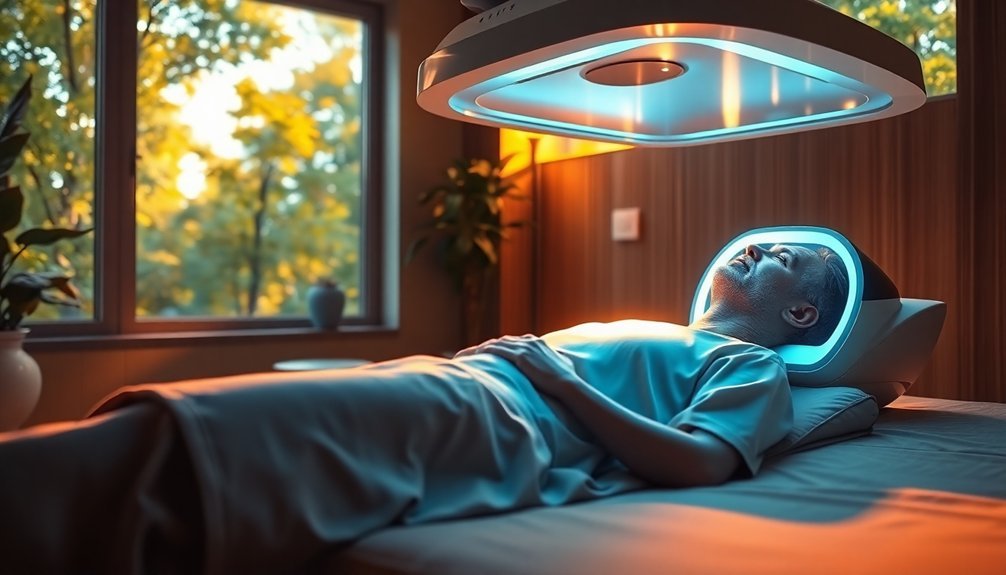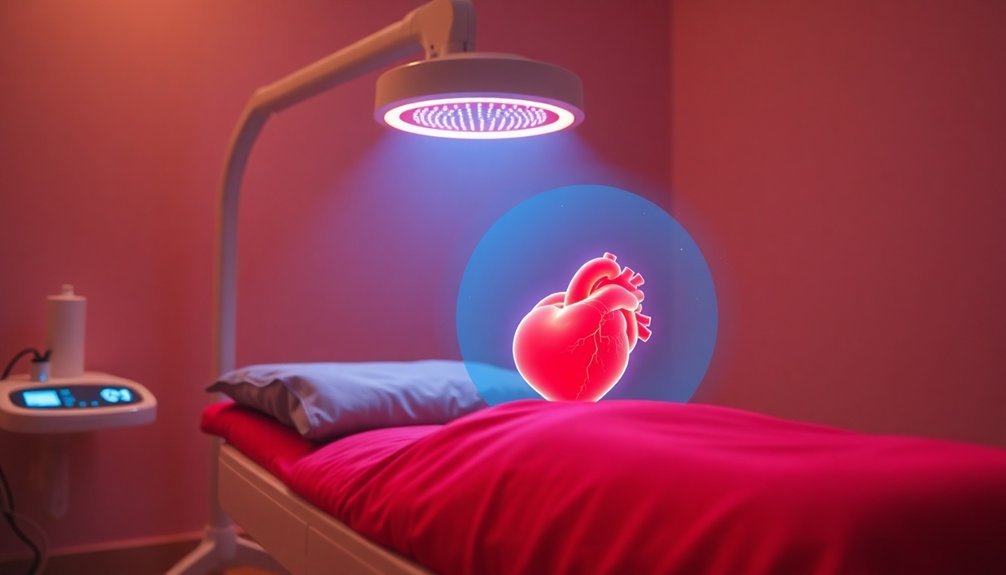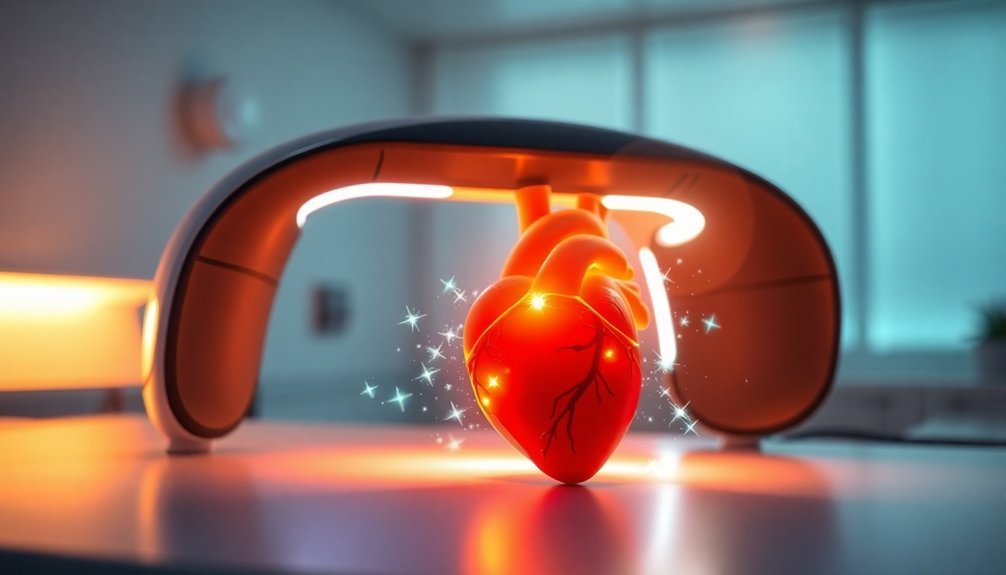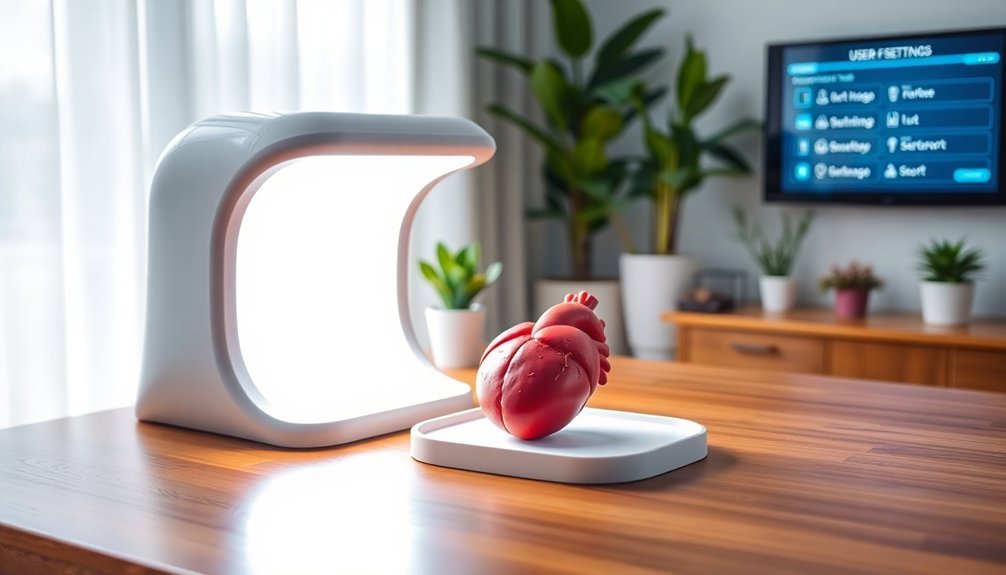Photobiomodulation (PBM) acts as a modern shield for your heart wellness by using light to boost cellular health. When light penetrates tissues, it energizes cells, enhancing ATP production and promoting blood flow. This process also releases nitric oxide, aiding in vasodilation and reducing oxidative stress. You'll find that PBM can lower inflammation and support heart recovery, which is crucial as you age. Studies show its positive effects on heart function, making it a promising therapy for heart health. Curious about how PBM can work specifically for you? There's so much more to uncover.
Understanding Photobiomodulation

Photobiomodulation (PBM) is a cutting-edge therapy that harnesses light to stimulate cellular function and promote healing.
When photons of light enter your cells, they're absorbed by specific molecules, primarily targeting cytochrome c oxidase (CcO) in the mitochondria. This is vital since CcO plays a significant role in the electron transport chain, which generates adenosine triphosphate (ATP) — your cells' energy currency.
As CcO absorbs the light, it stimulates ATP production, energizing your cells and improving metabolism. This process also triggers a biological cascade that results in the increased cellular metabolism, promoting healing and regeneration.
This process doesn't just boost energy; it also leads to the release of nitric oxide (NO), which reverses any cellular respiration inhibition caused by NO binding to CcO.
In addition, the increased ATP and NO help reduce oxidative stress, essential for preserving cellular health.
Benefits for Heart Function
A wealth of research shows that photobiomodulation (PBM) offers significant benefits for heart function. You'll find that PBM enhances blood flow and reduces red blood cell aggregation, promoting better oxygen delivery throughout your body. This technology stimulates nitric oxide production, which positively affects vasodilation, helping your blood vessels widen naturally.
Moreover, PBM reduces the size of myocardial infarctions, making heart recovery smoother, and it manages cardiac wall thickness effectively. In studies, PBM has shown to increase left ventricular ejection fraction in animal models, which suggests improved pump efficiency for your heart.
For older individuals, PBM decreases left ventricular mass and end-diastolic volume, combating the effects of cardiovascular aging. Additionally, PBM mitigates age-associated cardiovascular remodeling, reduces aortic wall stiffness, and enhances neuromuscular coordination. Notably, PBM's ability to improve mitochondrial health is crucial for maintaining optimal heart function in aging populations.
It also leads to increased cumulative survival rates in treated populations. On a cellular level, PBM improves microvascular flow, boosts ATP production, and activates stem cells, helping your heart heal from damage and reducing the risk of heart attacks and strokes.
Anti-Inflammatory Mechanisms

When it comes to heart wellness, understanding anti-inflammatory mechanisms is essential.
You'll find that increased adiponectin production, enhanced antioxidant defenses, and a reduction in pro-inflammatory markers play significant roles in promoting cardiovascular health. Furthermore, photobiomodulation (PBM) has been shown to modulate oxidative stress and influence gene expression related to healing processes, further supporting heart health. These factors collectively help create a healthier environment for your heart and overall well-being.
Increased Adiponectin Production
Adiponectin plays an essential role in regulating inflammation and promoting heart wellness. When you engage in photobiomodulation (PBM), you're helping your body produce more of this beneficial adipokine, which has significant anti-inflammatory effects. PBM works by stimulating chromophores in cells using specific wavelengths of light, primarily red and near-infrared. This process boosts mitochondrial activity, increasing ATP production, which indirectly promotes the production of adiponectin.
Here's how PBM impacts adiponectin production:
| Mechanism | Effect on Adiponectin | Additional Benefits |
|---|---|---|
| Chromophores Stimulation | Increases production | Enhances cellular functions |
| Mitochondrial Activity | Boosts energy levels | Improves overall metabolism |
| Calcium Ion Modulation | Regulates calcium levels | Influences secretion of adipokines |
| Cytokine Modulation | Upregulates IL-10 | Reduces inflammatory response |
Enhanced Antioxidant Defenses
Enhanced antioxidant defenses play an essential role in maintaining cellular health and combating inflammation. When you undergo photobiomodulation (PBM), you're not just boosting your body's immediate response but also markedly reducing oxidative stress.
By modulating reactive oxygen species (ROS), PBM helps keep ROS levels in check, particularly in stressed or diseased cells. This reduction in oxidative damage is crucial for your overall well-being.
As PBM activates your antioxidant defenses, you might visualize:
- A shield guarding against cellular wear and tear.
- Vibrant cells brimming with energy and vitality.
- Free radicals being neutralized like fire extinguished by water.
- An orchestra of cytokines playing harmoniously, promoting healing.
- A healthier heart, free from the shadows of inflammation.
Reduced Pro-Inflammatory Markers
While many treatments focus solely on alleviating symptoms of inflammation, photobiomodulation (PBM) offers a proactive approach by reducing pro-inflammatory markers at their source. PBM effectively downregulates pro-inflammatory cytokines like IL-1β, IL-6, and TNF-α, considerably lowering their levels in your body. This reduction helps diminish inflammation and alleviates the stress on your heart.
Here's a quick overview of how PBM modulates inflammatory responses:
| Mechanism | Effect |
|---|---|
| Downregulation of Cytokines | Reduces IL-1β, IL-6, TNF-α |
| Upregulation of Anti-Inflammatory Factors | Increases IL-10, TGF-β |
| Modulation of Inflammatory Cells | Lowers activity of macrophages, neutrophils |
Additionally, PBM boosts anti-inflammatory mediators, which fosters a more balanced immune response. By inhibiting reactive nitrogen species and promoting healthy cell activity, PBM enhances your body's ability to manage inflammation effectively. This thorough approach leaves you with a stronger shield against heart issues while supporting overall health.
Aging and Cardiovascular Health
As you age, your heart undergoes changes that can impact your overall cardiovascular health.
Understanding these age-related cardiac changes is essential for enhancing your longevity after 60 and preventing vascular decline.
Age-Related Cardiac Changes
Aging brings about significant changes in your heart's structure and function, which can impact overall cardiovascular health. You may notice that your heart enlarges, with thicker walls and slightly larger chambers. These changes contribute to an increase in left ventricular wall thickness due to hypertrophy of existing cardiomyocytes.
As you age, the heart's ability to function effectively declines, leading to less energy during physical activities.
Consider these notable changes:
- Increased left atrial dilation and hypertrophy due to more workload.
- Loss of elasticity in heart walls, resulting in stiffening.
- Decline in cardiac reserve, leading to reduced exercise capacity.
- Arteries and arterioles thickening, causing potential hypertension.
- Reduced sensitivity of baroreceptors, risking orthostatic hypotension.
These modifications aren't just cosmetic; they hold serious implications. For instance, they double your chances of experiencing heart failure, even if your ejection fraction remains normal.
Staying active and considering interventions like photobiomodulation therapy can help combat these effects, supporting healthier aging and preserving your heart's functionality. Prioritizing cardiac wellness now can pave the way for a stronger heart in your later years.
Enhancing Longevity Post-60
Improving cardiovascular health after 60 is essential for enhancing longevity and maintaining a vibrant lifestyle. One promising approach to achieving this is through photobiomodulation (PBM) therapy. Research indicates that PBM therapy greatly reduces age-associated increases in left ventricular mass and improves left atrial dimension. These changes help combat heart disease, which can become progressively severe with age.
Additionally, PBM not only benefits heart function but also enhances neuromuscular coordination. By improving gait symmetry, you're likely to experience better motor function and balance, which are vital as you age. These benefits from PBM persist even after temporary breaks in treatment, suggesting long-term enhancements to your physical performance.
Moreover, the longevity benefits of PBM therapy are notable. Studies have shown that PBM-treated subjects have a dramatically higher survival rate than untreated counterparts. This enhances lifespan by mitigating the progression of severe heart disease, while also elevating TGF-β1 levels, essential for regulating age-related diseases.
All these factors combined indicate that PBM therapy may serve as a key component in promoting heart wellness and increasing longevity as you navigate your golden years.
Preventing Vascular Decline
While vascular decline is a natural part of the aging process, it doesn't have to be inevitable. You can take proactive steps to prevent this decline and protect your heart health.
Photobiomodulation (PBM) is a powerful tool that uses near-infrared light to rejuvenate your vascular system. Research shows that by incorporating just a couple of minutes of PBM into your routine, you can:
- Stimulate the production of key growth factors that promote healing.
- Reduce inflammation, letting your blood vessels operate smoothly.
- Enhance microvascular flow, which is essential for nutrient delivery.
- Activate stem cells to repair and regenerate vascular tissues.
- Improve heart function metrics, leading to a healthier cardiovascular system.
How Photobiomodulation Works

Understanding how photobiomodulation (PBM) works reveals its remarkable ability to enhance cellular function through light therapy. When you expose tissues to non-ionizing light sources, like lasers or LEDs, photons are absorbed primarily by cytochrome c oxidase in the mitochondria. This process stimulates the electron transport chain, greatly increasing adenosine triphosphate (ATP) production, essential for cellular function, especially in damaged tissues.
As ATP levels rise, so does the mitochondrial membrane potential, energizing cellular metabolism. PBM also facilitates the release of nitric oxide, improving electron transport and further enhancing ATP production. Light exposure modulates reactive oxygen species, influencing cellular signaling and inflammation responses, and activates calcium ion channels that enhance signaling pathways.
Beyond those biochemical responses, PBM nurtures tissue repair by promoting blood vessel formation and reducing inflammation. This therapy accelerates healing processes for acute and chronic injuries while alleviating pain and supporting a healthier immune response.
Best of all, PBM is a non-invasive, non-thermal treatment, ensuring that you can benefit without side effects. By understanding PBM's mechanisms, you can appreciate its versatile applications for heart wellness and overall health.
Clinical Evidence and Studies
Clinical evidence highlights the promising potential of photobiomodulation (PBM) in addressing heart health. Numerous preclinical studies demonstrate the positive impact of LED-Red therapy on heart function and structure, particularly in heart failure models.
In these studies, you'll find impressive improvements in various metrics that matter to heart wellness:
- Increased ejection fraction and fractional shortening, showcasing better cardiac function
- Reduced pulmonary edema, alleviating fluid buildup in the lungs
- Enhanced myocardial tissue structure, leading to healthier heart morphology
- Reduced collagen deposition, which minimizes fibrosis in cardiac tissue
- Elevated ATP synthesis, fueling essential energy for your heart's needs
Furthermore, clinical trials targeting heart failure patients have begun to reveal benefits too. The primary endpoints focus on functional class and walking distance, showing hope for improved patient outcomes.
While some studies report conflicting results, the overall landscape suggests a need for future research to optimize PBM applications. This burgeoning field offers a glimpse into more effective treatments, possibly leading you to a healthier heart and enhanced quality of life.
Safety and Practical Use

Guaranteeing the safety and practical use of photobiomodulation (PBM) is essential for its effectiveness in promoting heart wellness. To achieve this, you must pay attention to specific light wavelengths, as ultraviolet and laser lights can be harmful.
Carefully adjusting the intensity and length of exposure is also important; non-thermal exposure prevents tissue damage. Incorrect doses can lead to a biphasic response, making therapy ineffective or even detrimental. Consequently, monitoring and adhering to established parameters is critical.
For practical application, you can use overhead LED lights or devices like the Firewave or Weber Medical Helmet. Treatment sessions are brief, typically under 15 minutes, and frequency often ranges from daily to five days a week.
Ambient low-dose exposure can be achieved using red or near-infrared light in a non-focused manner. Numerous devices, including LED panels and handheld tools, are available for various treatment areas. These should be calibrated for proper wavelength and intensity.
Finally, integrating PBM into healthcare routines may enhance recovery and performance, and training for healthcare providers guarantees safe application in clinical and home settings.
Frequently Asked Questions
Can PBM Therapy Be Used Alongside Other Heart Treatments?
Yes, you can use PBM therapy alongside other heart treatments. It's non-invasive and won't interfere with medications or surgeries, enhancing cardiac function and reducing symptoms, making it a versatile addition to your treatment plan.
How Long Do the Effects of PBM Last?
The effects of PBM can last from days to weeks after treatment. For chronic conditions, ongoing sessions help maintain benefits, while acute improvements can often be sustained with just a few initial treatments.
Is PBM Suitable for Everyone, Including the Elderly?
PBM isn't suitable for everyone; however, it shows promise for the elderly. It can improve heart function, slow age-associated deterioration, and enhance overall health, but individual suitability should always be assessed by a healthcare professional.
What Are Common Side Effects of PBM Therapy?
Common side effects of PBM therapy include potential eye damage without goggles, skin redness, headaches, and local pain. It's essential you consult a healthcare provider if you have specific medical conditions before starting treatment.
How Much Does PBM Therapy Typically Cost?
PBM therapy typically costs between $25 and $200 per session, depending on treatment type and area size. You might find at-home devices cheaper, but professional treatments generally yield better results due to increased power.
In Summary
Incorporating photobiomodulation into your wellness routine could be a game-changer for your heart health. This innovative therapy not only enhances heart function but also fights inflammation and supports healthy aging. With a growing body of clinical evidence backing its effectiveness, you can feel confident exploring this safe and practical approach. So, why not give your heart the modern shield it deserves? Embrace photobiomodulation and take a proactive step towards a healthier, happier you.





Leave a Reply